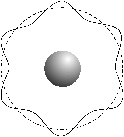de Broglie's Standing Waves to explain the observed stability of electron orbitals
| The atoms themselves contain numerous scale structures. For instance, experiments showed that electrons cannot exist but in defined orbitals which step up in quantum leaps between energy states. The stepwise (scale-like) ‘permissible orbits’ and energy levels of the atom could not be explained in terms of the Newtonian model , since orbiting objects are by definition accelerating and should therefore be gradually losing energy, and thus should be expected to spiral in towards the nucleus eventually crashing into it. But this was not in accord with the observed facts. What therefore was it that kept the electrons within their discrete ‘scale-like’ positions at particular distances from the nucleus? In 1923, de Broglie, in a stroke of intuitive genius, proposed that a way to explain the discrete energy levels was that electrons behave like waves . The only way to ‘fit a wave’ around a nucleus is when the wavelength fits the circumference a whole-number of times. Such waves that fit a whole-number of times are called ‘standing waves ’, and these states or positions, reasoned de Broglie , should correspond to the observed energy levels of the electrons . This brilliant insight together with his theory that if light could behave like particles (photons ) then particles should exhibit wave-like properties , was later confirmed by experiment, and earned him a Nobel Prize in physics. This then, is an extremely beautiful and literal example of ‘resonant scale structure’ connecting circles, waves, and the whole numbers . De Broglie’s predictions for the electron orbitals (on the basis of waves whose wavelengths could fit a whole number of times around the nucleus) were quickly confirmed by experiment and were found to perfectly fit the observed energy levels of electrons in atoms. |
|

Illustrating a 'standing wave'—one whose wavelength fits a whole-number of times around the circumference of its orbital path.
| back to top |
next > |